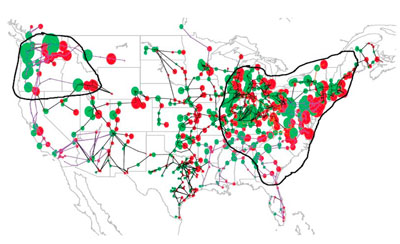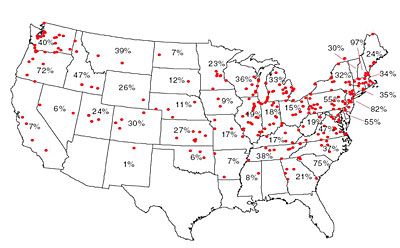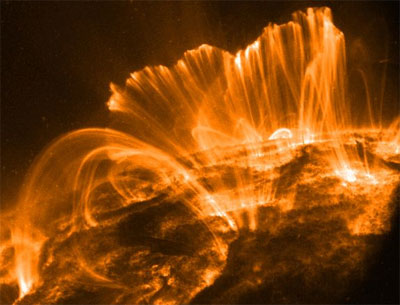The EMP threat: fact, fiction, and response (part 2)by Yousaf M. Butt
|
| If a terrorist cell miraculously built such a weapon, they are likely to explode their “crown jewel” in a simple spectacular ground-burst that will destroy a large part of a city, and not risk the complications—and likely failure—of a lofted EMP strike. |
Thus, it is not at all a simple matter, even for countries with considerable resources and focused decades-long effort, to build such weapons, let alone pair them to reliable delivery systems. As carefully argued by John Mueller in his new book, Atomic Obsession, it is virtually impossible for a terrorist cell to obtain the raw materials needed for a nuclear device and assemble it correctly themselves [Ref 22, p. 172–198]. Even a “crude” U-type device is not all that “crude” and requires the concerted effort of skilled scientists and engineers. Any weapon produced by a terrorist cell would likely be a one of a kind and would have to remain untested. For a terrorist group to then mate this weapon to a ballistic missile and successfully carry out an EMP strike beggars belief. As John Pike, director of GlobalSecurity.org has said, “It is just very difficult to imagine how terrorists are going to be able to lay hands on a nuclear-tipped missile, and launch it and reprogram it in such a way that it would be a high-altitude burst like that.”
Dr. Philip Coyle, former Pentagon director of operational test and evaluation, has stated that the EMP commission’s report appeared to “extrapolate calculations of extreme weapons effects as if they were a proven fact, and further to puff up rogue nations and terrorists with the capabilities of giants.” The 2009 Strategic Posture Commission puts it more delicately by saying that “the Commission is divided over how imminent a threat this is…”
If a terrorist cell miraculously built such a weapon, they are likely to explode their “crown jewel” in a simple spectacular ground-burst that will destroy a large part of a city, and not risk the complications—and likely failure—of a lofted EMP strike that will, if all goes according to their plan, cause casualties via unpredictable secondary effects upon a limited part of some of the nation’s infrastructure. The risk versus reward calculation for both terrorists cells and so-called “rogue” states would almost certainly force their hand to a spectacular and direct ground burst in preference to a unreliable and uncertain EMP strike. A weapon of mass destruction is preferable to a weapon of mass disruption.
A state would be highly unlikely to launch an EMP strike from their own territory because the rocket could be traced to the country of origin and would probably result in nuclear or massive conventional retaliation by the US. The EMP commission also considers adversarial nations carrying out a shipborne EMP attack that would be less traceable. However, even so, there would some small risk of trace-back that would give the leadership in such nations pause. While nuclear forensics are not well enough developed to assuredly ascribe the origin of a nuclear explosion, even their current state of development would, in some measure, dissuade the leaders of a nation from seriously contemplating such an attack. Furthermore, the US certainly has data, via its DSP satellites, on the infrared (IR) signatures of the rocket exhausts from the missiles of various countries. Though these signatures are probably virtually identical for the Scud/Shahab/No-dong family of missiles, the nations which may entertain such attacks do not necessarily know whether, e.g., the DSP data can discriminate between a NK Nodong versus an Iranian Shahabs, perhaps due to differences in fuel and/or subtle design idiosyncrasies. This is data only the US has, and it has an inherent deterrent value to nations thinking about launching an EMP strike via a ship-launched ballistic missile. This is almost certainly the case if, say, Iran were to use its solid rocket motor technology to launch such a strike—if and when Iran obtains nuclear weapons, of course. In such a case, the burn time-profile and solid-motor IR signatures could probably be used to tie the missile to a nation.
Furthermore, the leaders of a nation contemplating such an attack would have to carefully consider what would happen in case the warhead was not delivered properly. If it fell short and/or did not explode, it may be possible for US engineers and scientists to ascribe a national origin given the forensic material. For the leadership of any nation to chance such an attack they must be almost suicidally optimistic: they would have to presume that everything would go perfectly. Even so, it may still be possible to identify the country of origin, which would invite massive US retribution.
What about an adversarial nation “sub-contracting” its dirty work to a terrorist cell? Again, there would be substantial doubt in the nation’s leadership as to whether or not forensic evidence (whether the device exploded or not) could tie them to the weapon. In any case, as argued by Mueller [Ref 22, p. 163] it is highly unlikely that a nation would give one of its crown jewels to an unpredictable terrorist cell. At least in the case of Iran, this view is supported by in-depth research done by authors at the National Defense University, who conclude, “[W]e judge, and nearly all experts consulted agree, that Iran would not, as a matter of state policy, give up its control of such weapons to terrorist organizations and risk direct U.S. or Israeli retribution.”
Though they possess the technological know-how to fabricate a powerful EMP device, the possibility of China or Russia carrying out such an attack is virtually nil. Not only for the regular military deterrent reasons but also, post-Cold War, our economies are intimately linked, which amounts to an inherent economic deterrent. The latter is likely the more relevant deterrent [Ref. 22, p. 65]. We owe China tremendous sums of money, they need us as a market, and both the US and China require Russian oil via intertwined world markets. Although the EMP commissioners have offered a Chinese-language PowerPoint presentation outlining the effects of EMP devices as evidence that China has an interest in such weapons, this presentation is actually of Taiwanese origin [“Electromagnetic Pulse Attack and Defense”, by Dr. Chien Chung], and it is not pertinent to any official Chinese military doctrine.
| It is virtually guaranteed that a powerful geomagnetic storm, capable of knocking out a significant section of the US electrical grid, will occur within the next few decades. |
More importantly, the DoD itself has weighed in on the issue in its “Militarily Critical Technologies List”. This is a detailed compendium of the technologies the DoD assesses as critical to maintaining superior United States military capabilities. Part II, “Weapons of Mass Destruction Technologies,” addresses those technologies required for development, integration, or employment of biological, chemical, or nuclear weapons and their means of delivery against the US. This document states that “HEMP can pose a serious threat to U.S. military systems when even a single high-altitude nuclear explosion occurs. In principle, even a new nuclear proliferator could execute such a strike. In practice, however, it seems unlikely that such a state would use one of its scarce warheads to inflict damage which must be considered secondary to the primary effects of blast, shock, and thermal pulse. Furthermore, a HEMP attack must use a relatively large warhead to be effective (perhaps on the order of one megaton), and new proliferators are unlikely to be able to construct such a device, much less make it small enough to be lofted to high altitude by a ballistic missile or space launcher.”
Lastly, General Robert T. Marsh, former Chairman of the President’s Commission on Critical Infrastructure Protection concluded (in 1997) that he did not, “see any evidence that suggests capabilities seriously threatening our critical infrastructure… There are many easier, less costly, and more dramatic ways for terrorists to use nuclear weapons than delivery to a high altitude. Such an event is so unlikely and difficult to achieve that I do not believe it warrants serious concern at this time.”
The real threat: geomagnetic storms
For the reasons outlined above, it is highly unlikely that any adversary would choose to—or, in the case of a terrorist cell, even be remotely capable of—carrying out a nuclear EMP strike against the US. However, it is virtually guaranteed that a powerful geomagnetic storm, capable of knocking out a significant section of the US electrical grid, will occur within the next few decades. In fact, this may well happen even within next few years as we approach the next period of elevated solar activity, known as “solar maximum”, which is forecast to peak in 2013. Geomagnetic storms are E3-like: low-intensity but long-lasting and low-frequency coupling to long-lines.
The first recorded evidence of space weather effects on technology was in 1847 when currents were registered in electric telegraph wires. Later, in 1859, a major failure of telegraph systems in New England and Europe coincided with a large solar flare called the “Carrington Event”, after astronomer Richard Carrington who witnessed the instigating flare. However, the real modern-era wakeup call to geomagnetic susceptibility of our infrastructure was the (moderate intensity) geomagnetic storm that shut down the entire Hydro Quebec grid in March 1989. There were also reports of computer failures in August of that year in Toronto, Canada (which possibly indicate that the associated geomagnetic activity had considerably faster components than just E3).
Geomagnetically induced currents (GICs) in long-line power delivery systems are caused by the rate-of-change of the geomagnetic field, just as in an E3 pulse. Thus the severity of such geomagnetic field disturbances is measured in nanotesla per minute (nT/min). Experience with modern-day infrastructure indicates failures can result even at relatively low-threat intensities. For example, the instigating activity associated with the Hydro Quebec collapse mentioned above only reached an intensity of ~480 nT/min. Solar storms on other occasions have been known to produce geomagnetic disturbances of ~2000 nT/min, and a solar storm on May 14–15 in 1921 may have produced a disturbance of 4800 nT/min. [23]. As Mr. Kappenman states [23], “analysis indicates that storms with...excursions of ~2800 nT/min have been observed at geomagnetic latitudes of concern for modern day infrastructures. Further anecdotal evidence suggests that... ~5000 nT/min may have occurred during the Great Geomagnetic Storm of May 1921.”
| Our electric power grid has continued to become more vulnerable to disruption from geomagnetic storms. |
To understand the effects of such GIC on the electric grid we may examine the August 2003 Northeast Blackout, which was not geomagnetically induced. (It reportedly originated when high-voltage power lines came in contact with “overgrown trees”.) This outage affected the Northeast US and parts of Canada and more than 200 power plants, including several nuclear plants, were shut down as a result of the electricity cutoff. Other effects included loss of water pressure, possible sewage contamination, gridlock, various other transportation problems (because of secondary effects on railways, airlines, and gas stations), and disruption of oil refineries’ operations. Phone service was stressed due to the high call volume and several radio and television stations went off the air. It is estimated that the one-day blackout cost $7–10 billion in spoiled food, lost production, overtime wages, and other related expenses inflicted on more than one-seventh of the US population. [24]
A similar vegetation-induced outage in Europe occurred on September 28, 2003, when “at 3.01 a.m., one of the main north-south transit lines – the Lukmanier transmission line – shut down following a flash-over between a conductor cable and a tree”. The blackout affected about 56 million people although electricity was restored gradually (about 3–6 hours) in most places, and in most cities electricity were powered on again during the morning. Rolling blackouts reportedly continued to affect about 5% of the population for the next two days as repairs were being made.
Although the August and September 2003 outage was not geomagnetic in origin, solar outbursts during late October and early November 2003 triggered severe geomagnetic storms, with wide-ranging effects that were described as follows in a 2008 National Academy of Sciences (NAS) study [25]:
The Sydkraft utility group in Sweden reported that strong geomagnetically induced currents (GIC) over Northern Europe caused transformer problems and even a system failure and subsequent blackout. Radiation storm levels were high enough to prompt NASA officials to issue a flight directive to the [International Space Station] astronauts to take precautionary shelter. Airlines took unprecedented actions in their high latitude routes to avoid the high radiation levels and communication blackout areas. Rerouted flights cost airlines $10,000 to $100,000 per flight. Numerous anomalies were reported by deep space missions and by satellites at all orbits. GSFC Space Science Mission Operations Team indicated that approximately 59% of the Earth and Space science missions were impacted. The storms are suspected to have caused the loss of the $640 million ADEOS-2 spacecraft. On board the ADEOS-2 was the $150 million NASA SeaWinds instrument. Due to the variety and intensity of this solar activity outbreak, most industries vulnerable to space weather experienced some degree of impact to their operations.
Even more serious effects can be expected during future powerful geomagnetic storms. To quote the NAS study [25]:
Because of the interconnectedness of critical infrastructures in modern society, the impacts of severe space weather events can go beyond disruption of existing technical systems and lead to short-term as well as to long-term collateral socioeconomic disruptions… Collateral effects of a longer-term outage would likely include… disruption of the transportation, communication, banking, and finance systems, and government services; the breakdown of the distribution of potable water owing to pump failure; and the loss of perishable foods and medications because of lack of refrigeration. The resulting loss of services for a significant period of time in even one region of the country could affect the entire nation and have international impacts as well.
Our electric power grid has continued to become more vulnerable to disruption from geomagnetic storms. For example, the power delivery system is now operating closer to margin, than in the past. As Kappenman states, “many of the things that we have done to increase operational efficiency and haul power long distances have inadvertently and unknowingly escalated the risks from geomagnetic storms.” [25]
The possible extent of a power system collapse from a 4800 nT/min geomagnetic storm (centered at 50° geomagnetic latitude) is shown in Figure 2. Similar levels—10 times those experienced during the March 1989 storm—were reached during the great magnetic storm of May 14–15, 1921. A nuclear weapon would need to be a ~multi-megaton size to cause the equivalent E3 damage [15].
 Figure 2: Scenario showing effects of a 4800 nT/min geomagnetic field disturbance at 50° geomagnetic latitude scenario. The regions outlined are susceptible to system collapse due to the effects of the GIC disturbance; the impacts would be of unprecedented scale and involve populations in excess of 130 million. SOURCE: J. Kappenman, Metatech Corp., “The Future: Solutions or Vulnerabilities?,” presentation to the NAS space weather workshop, May 23, 2008. [25] |
The most serious outcome of such power delivery system failures is damage to the transformers, although other critical systems on the grid are also at risk. As the NAS study points out, transformers experience “excessive levels of internal heating brought on by stray flux when GICs cause a transformer’s magnetic core to saturate and to spill flux outside the normal core steel magnetic circuit… previous well-documented cases have involved heating failures that caused melting and burn-through of large-amperage copper windings and leads in these transformers. These multi-ton apparatus generally cannot be repaired in the field, and if damaged in this manner, they need to be replaced with new units, which have manufacture lead times of 12 months or more.”
Metatech Corp. estimates that more than 300 large extra-high voltage (EHV) transformers would be exposed to levels of GIC sufficiently high to place these units at risk of failure or permanent damage requiring replacement [25]. Figure 3 shows an estimate of percent loss of EHV transformer capacity by state for a 4800 nT/min threat environment such as might occur during a storm of the magnitude of the May 1921 event. As a recent article in the journal Science states, “The surging power-line currents induced by a severe solar storm could push the grid into uncharted territory.” [26]
 Figure 3: A map showing the at-risk transformer capacity (estimated at ~365 large transformers) by state for a 4800 nT/min geomagnetic field disturbance at 50° geomagnetic latitude. Regions with high percentages of at-risk capacity could experience long-duration outages that could extend multiple years. SOURCE: J. Kappenman, Metatech Corp., “The Future: Solutions or Vulnerabilities?,” presentation to the NAS space weather workshop, May 23, 2008. [25] |
In summary, current US grid operational procedures are based largely on limited experience, generally do not reduce GIC flows, and are unlikely to be adequate for historically large disturbance events. Historically large storms have a potential to cause power grid blackouts and transformer damage of unprecedented proportions, long-term blackouts, and lengthy restoration times, and chronic shortages for multiple years are possible [25].
